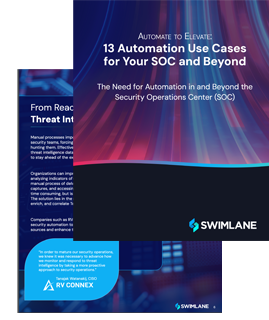Cybersecurity threats are often described in military terms. This is not an accident.
Like an army tasked with defending territory, a cybersecurity team needs to understand the threats it faces. Their responses must be quick and meaningful. Otherwise, they may face defeat.
Recent events have given us a better idea of what cyber defeat looks like, and it’s not pretty. Whether it’s a data breach that costs an average of $4.24 million, a political leader targeted by hacking or government data being compromised – the stakes are high. Cybersecurity teams need to understand what malicious actors and hacking techniques are headed their way and what to do about them.
We are starting to get a much better idea of what a cyber defeat looks like, and it’s not pretty.
In response, the cybersecurity field developed threat intelligence, which focuses on identifying threats before they become breaches.
What is Threat Intelligence?
Gartner defines threat intelligence as “evidence-based knowledge, including context, mechanisms, indicators, implications and actionable advice, about an existing or emerging menace or hazard to assets that can be used to inform decisions regarding the subject’s response to that menace or hazard.”
The types of threat intelligence include:
- Strategic threat intelligence: focuses on broader, high-level trends. Intelligence is used for business decision-making, commonly among executive boards and CISOs.
- Tactical threat intelligence: focuses on threat actor behavior, TTPs and incident reports that are then used by SOC analysts and security solutions.
- Operational threat intelligence: focuses on the events and campaigns surrounding cyber attacks, which is then used by the SOC manager, threat hunters and other proactive team members.
Why is Threat Intelligence Important?
Threat intelligence is critical to the success of a security operations center (SOC). Compiling and using cyber threat intelligence data is key for keeping pace with the growing threat landscape. Analyzing indicators of compromise (IOCs) allow organizations to preemptively up their defenses based on the latest trends and evolutions of cyber threats. However, it’s a challenge to leverage comprehensive data throughout a security infrastructure effectively, which makes the process inefficient and time-consuming.
Threat intelligence helps in the following ways:
- Adds context to otherwise unknown threats
- Reveals the tactics, techniques and procedures (TTPs) of malicious actors
- Equips security teams to make more informed decisions and prevent data loss
- Increases security efficiency, which helps show the clear business value to stakeholders
Threat Intelligence Challenges
While there are tools that help organizations improve their cyber threat intelligence, the ever-changing landscape of the threat environment requires organizations to regularly update their systems. To stay vigilant, threat intelligence feeds must have the latest IOCs. But manually ensuring accurate validation of security alarms against the latest IOCs is a time-consuming, inefficient process.
Disparate systems require security analysts to jump from platform to platform to gather all the information they need to appropriately handle threats. When done manually, analysts:
- Receive an alert
- Check cyber threat intelligence feeds
- Compile threat information
- Make a decision
- Submit network change requests
By the time an analyst completes these tedious required steps, a malicious actor already could have gathered all the information needed and breached the system.
Massive amounts of data from different sources, manual methods, lack of IT resources (both staff and technology), and the wrong tools can delay and even halt the productive use of threat intelligence in making quick decisions that protect businesses from cyber-attacks.
Threat Intelligence Tools
Threat intelligence solutions help security organizations get out ahead of threats. These tools can analyze inputs from multiple data streams, such as device logs and external threat intelligence sources, and then report on potential threats including:
- Possible malware in the network, like infections targeting internal hosts that seem to be communicating with external malicious actors.
- Email attacks from attachments and links to malicious domains.
- Host-based malware that targets filenames, registry keys, etc.
Threat intelligence platforms are necessary because it is simply impossible for a security analyst to collect and interpret the vast volumes of alert data produced by SIEMs, intrusion detection tools and related systems without assistance.
Automated Threat Intelligence Enrichment
To streamline actions throughout the SOC, security teams utilize security automation for automated threat intelligence enrichment. Security automation provides a cohesive system to achieve greater situational awareness of threats, both in the present and the future. It speeds up and improves the efficacy of the detect-assess-respond threat intelligence cycle by:
- Help teams react faster and more intelligently to threats
- Identify and prioritize the most relevant and actionable threat intelligence data
- Integrate threat intelligence into the incident response and remediation process
Low-code security automation consolidates data like security events, incidents, alerts, and cases from SIEM solutions and other security tools. It then correlates that data from cyber threat intelligence tools to identify activity from malicious IP addresses, domains, and email addresses to automatically initiate an incident response process and terminate threats at machine speeds.
Security automation tools, like Swimlane Turbine, integrate threat intelligence as part of the incident and remediation process, consolidating all security events, incidents, alerts and other tasks into a single location for a more cohesive view of current and potential threats. In addition to automating routine security tasks, Turbine provides centralized access to cases, reports, dashboards and metrics for authorized users.
Watch Swimlane Turbine automate the threat intelligence & IOC lookup process.
Using low-code security automation for automated threat intelligence enrichment, organizations can:
- Standardize security investigations and processes for improved efficiency
- Consolidate all relevant security information into customizable dashboards
- Automate redundant and tedious investigation steps
- Improve collaboration
- Prioritize alerts
- Increase situational awareness
- Optimize attack chain response
- Gain a broader understanding of threat intelligence
Using customized dashboards, security analysts can review data directly in Turbine without the need to cut and paste data into other programs. At the same time, threat intelligence tables can be manipulated to look for new threats or find new associations that can help to develop preventative or responsive action.
With faster incident response times, improved efficiency and optimized security processes, organizations can be confident their SecOps teams will stop real threats before they cause harm, rather than being bogged down with tedious manual tasks.

E-book:Top 13 Automation Use Cases for Your SOC and Beyond
In “Automate to Elevate: 13 Automation Use Cases for Your SOC and Beyond” Ebook, we invite you to discover the limitless opportunities of AI enabled security automation in and beyond the SOC.


